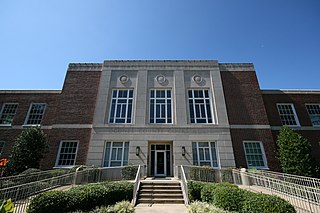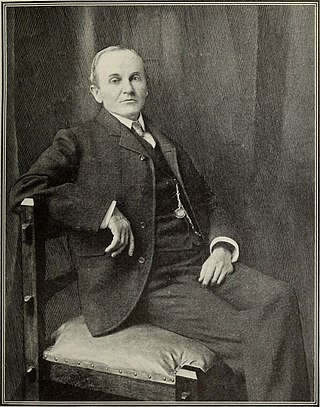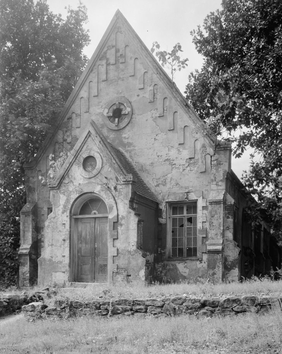
Milledgeville is a city in and the county seat of Baldwin County in the U.S. state of Georgia. It is northeast of Macon, bordered on the east by the Oconee River. The rapid current of the river here made this an attractive location to build a city. It was the capital of Georgia from 1804 to 1868, including during the American Civil War. Milledgeville was preceded as the capital city by Louisville and was succeeded by Atlanta, the current capital. Today U.S. Highway 441 connects Milledgeville to Madison, Athens, and Dublin.

Watkinsville is the largest city and county seat of Oconee County, Georgia, United States. As of the 2020 census, the city had a total population of 2,896. It served as the seat of Clarke County until 1872 when the county seat of that county was moved to Athens, a move which ultimately led to the creation of Oconee County in 1875. It is included in the Athens-Clarke County, Georgia Metropolitan Statistical Area.

Athens is a consolidated city-county in the U.S. state of Georgia. Downtown Athens lies about 70 miles (110 km) northeast of downtown Atlanta. The University of Georgia, the state's flagship public university and an R1 research institution, is in Athens and contributed to its initial growth. In 1991, after a vote the preceding year, the original City of Athens abandoned its charter to form a unified government with Clarke County, referred to jointly as Athens–Clarke County where it is the county seat.

The University of Georgia is a public land-grant research university with its main campus in Athens, Georgia, United States. Chartered in 1785, it is the oldest public university in the United States. It is the flagship school of the University System of Georgia.

Athens Academy is a private, co-educational, college preparatory school in Athens, Georgia. As of 2017, the school enrollment is approximately 945 students.

WGTA is a television station licensed to Toccoa, Georgia, United States, serving much of the northeastern portion of the state. The station is owned by Marquee Broadcasting, and has studios on Big A Road in Toccoa; its transmitter is located northwest of Black Rock Mountain outside of Toccoa in unincorporated Stephens County.

The Tree That Owns Itself is a white oak tree that, according to legend, has legal ownership of itself and of all land within eight feet (2.4 m) of its base. Also known as the Jackson Oak, the tree is at the corner of South Finley and Dearing Streets in Athens, Georgia, US. The original tree, thought to have started life between the mid-16th and late 18th century, fell in 1942, but a new tree was grown from one of its acorns and planted in the same location. The current tree is sometimes referred to as the Son of the Tree That Owns Itself. Both trees have appeared in numerous national publications, and the site is a local landmark.

Walter Barnard Hill was chancellor of the University of Georgia (UGA) in Athens from 1899 until his death in 1905.
Omer Clyde "O.C." Aderhold was President of the University of Georgia (UGA) in Athens from 1950 until 1967.
WUGA is a public FM radio station serving Athens and much of the northeast part of Georgia. It is a member of Georgia Public Broadcasting's radio network but is operated by the University of Georgia, with studios and offices located at the Georgia Center for Continuing Education on the UGA campus. The transmitter is located off Walter Sams Road in Winterville, Georgia, southeast of Athens.
The University of Georgia College of Environment and Design (CED) is a college within the University of Georgia (UGA) in Athens, Georgia, United States.

Henry Hull Carlton was an American politician, medical doctor, journalist and soldier.

Oconee Hill Cemetery is a cemetery in Athens, Georgia, United States. The extant cemetery opened in 1856 and is located near the University of Georgia.
The Oconee War was a military conflict in the 1780s and 1790s between European Colonists and the Creek Indians known as the Oconee, who lived in an area between the Apalachee and North Oconee rivers in the state of Georgia.

The North Oconee River Greenway Network is a system of linear parks and trails constituting a total of 8 paved miles in Athens, Georgia. It consists of a mixture of unpaved and paved multi-use trails abutting the Oconee River, some of its minor tributaries and other parks within the county. The network continues to be expanded primarily through the use of TSPLOST funding in addition to funding from Georgia Department of Transportation. The network utilizes a mixture of rail-to-trail and riparian right of ways.

Iron Horse is a 2-ton, 12-foot-tall iron sculpture created by Abbott Pattison. Although the sculpture was not well-received at first, as of the second decade of the twenty-first century it is visited by many tourists and University of Georgia students.

The Athens Regional Library System (ARLS) is a consortium of 11 public libraries across five counties, comprising the Athens – Clarke County metropolitan area as well as Franklin County in northeast Georgia, United States.

St. Mary's Episcopal Church was an Episcopal church in Athens, Georgia, United States. Completed in 1869, it came to prominence after the musical group R.E.M., then without a name, played its first concert there in 1980.
Robert Lee Bloomfield was an American businessman and church-founder.
Linnentown was a Black neighborhood in Athens, Georgia that was destroyed in the 1960s by an urban renewal project of the University of Georgia (UGA) and the city government of Athens. Comprising an area of 22 acres, the neighborhood had about fifty families who were forced out, via eminent domain, to make room for student housing for UGA; the dormitories, Russell Hall, Creswell Hall, and Brumby Hall now stand on the site. UGA associate professor of Geography, Jerry Shannon, estimates that the combination of undervaluing the property at the time of sale and forcing residents into areas "of the city where property values have not climbed as quickly" has cost residents over $5 million of generational wealth.















